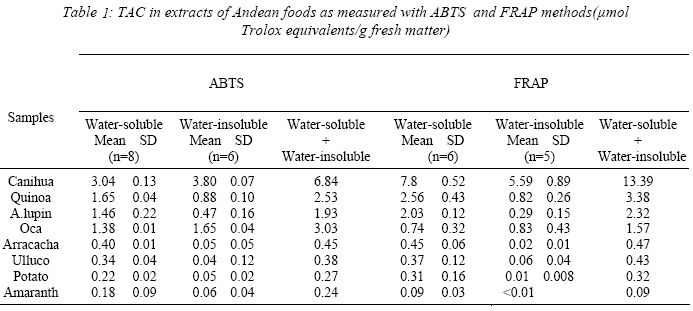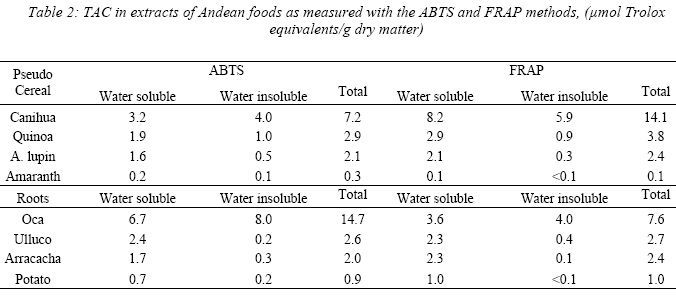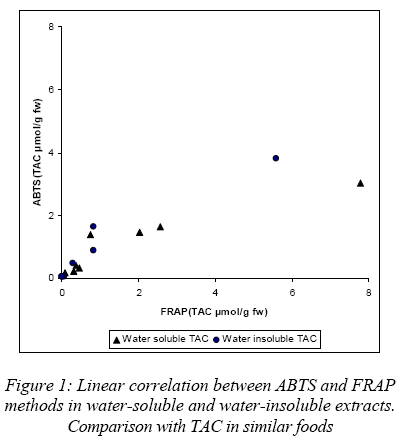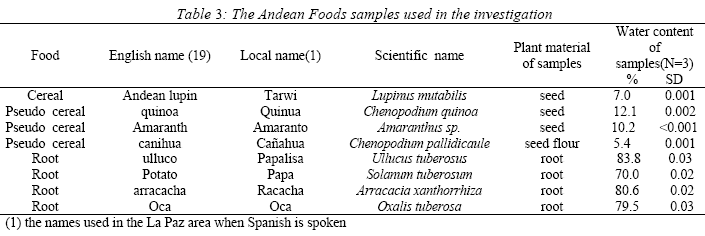Revista Boliviana de Química
versión On-line ISSN 0250-5460
Rev. Bol. Quim v.22 n.1 La Paz 2005
ARTÍCULO ORIGINAL
TOTAL ANTIOXIDANT CAPACITY IN ANDEAN FOOD SPECIES FROM BOLIVIA
J. Mauricio Peñarrietaabc, J. Antonio Alvaradoa, Björn Ǻkessonb* and Björn Bergenståhlc
aInstituto de Investigaciones Químicas, Universidad Mayor de San Andrés, La Paz, Bolivia,
bBiomedical Nutrition, Lund University , Lund, Sweden,
cFood Technology, Lund University, Lund, Sweden jaalvkir@gmail,com
ABSTRACT
As a part of a study on the content of antioxidants in Bolivian foods, the Total Antioxidant Capacity (TAC) in some Andean foods has been measured. Eight Andean foods were analyzed by two methods, ABTS and FRAP to assess TAC. The selected plants were : andean lupin (Lupinus mutabilis), quinoa (Chenopodium quinoa), amaranth (Amaranthus sp.), ulluco (Ullucus tuberosus), potato (Solanum tuberosum), arracacha (Arracacia xanthorrhiza), oca (Oxalis tuberosa) and canihua (Chenopodium pallidicaule). The highest TAC value was observed in canihua both in the water-soluble fraction and in the water-insoluble fraction. Intermediate values were found in oca, andean lupin and quinoa, and lower TAC values were demonstrated in potato, arracacha, ulluco and amaranth. TAC values obtained by the two methods showed significant linear correlations both for the water–soluble fractions (r=0.92) and water–insoluble fractions (r=0.95). Further studies are necessary to identify the compounds responsible for the antioxidant capacity of these foods.
Key words: Andean Foods, total antioxidant capacity, TAC, FRAP,ABTS.
RESUMEN
Como parte del estudio sobre el contenido de antioxidantes en alimentos de Bolivia, la Capacidad Antioxidante Total (TAC) fue determinada en algunos Alimentos Andinos. Ocho Alimentos Andinos fueron analizados por ABTS y FRAP, dos métodos para determinar TAC. Las plantas seleccionadas fueron Tarwi (andean lupin; Lupinus mutabilis), quinua (quinoa; Chenopodium quinoa), amaranto (Amaranthus sp.), ulluco (Ullucus tuberosus), popa (Solanum tuberosum), arracacha (Arracacia xanthorrhiza), oca (Oxalis tuberosa) y cañahua (canihua; Chenopodium pallidicaule). Un alto valor de TAC fue observado en canihua en ambas fracciones acuosa y no acuosa. Los valores intermedios de TAC fueron determinados en oca, Tarwi y quinua, y los valores bajos de TAC fueron determinados papa, arracacha, ulluco y amaranto. Los valores de TAC obtenidos por los dos métodos mostraron correlacion lineal significativa tanto para fracciones acuosas (r=0.92) y fracciones no acuosas (r=0.95).Más estudios son necesarios a fin de identificar los compuestos responsables de la capacidad antioxidante de estos alimentos.
INTRODUCTION
There is a variety of endemic foods in the Andes such as roots, cereals and pseudo-cereals all growing at high altitudes ranging between 2000 and 4200 m above sea level (1). This part of the world contributed with potato and corn to the world kitchen, and still has a multitude of potato and corn varieties farmed and wild. It is also an important ecosystem to be studied further both from a food point-of-view and other perspectives. There is growing scientific evidence that an increased consumption of fruits, vegetables and other plant foods has health-promoting effects since it is linked to lower incidence of cardiovascular disease and certain types of cancer disease (2-4). The high content of antioxidants and other bioactive compounds in many of these foods may be responsible for such effects but the active substances have not been established. The general hypothesis about the antioxidant action mechanism is that antioxidants decrease different forms of free-radical-induced damage in the organism by inhibiting processes like LDL oxidation and protecting DNA and proteins against lipid peroxidation. Moreover several studies have shown that Andean food varieties have health-promoting effects, for example the purple corn was shown to inhibit colorectal carcinogenesis in male rats (5, 6), and red sweet potato (Ipomoea batatas) and macho altea (Hypsocharis pimpinellifolia) showed antimutagenic properties (7,8).
The aim of this work was to perform the first evaluation of Total Antioxidant Capacity (TAC) of representative agricultural products from the Bolivian highland. TAC was measured in some food samples selected from the local markets in La Paz by two methods, ABTS (9) and FRAP (10). ABTS and FRAP methods were chosen for their extensive usage to determine the TAC (11, 12).
RESULTS AND DISCUSSION
Total antioxidant capacity of Andean foods
The TAC values of the eight samples as measured by the ABTS and FRAP methods in the water-soluble and water-insoluble fractions are shown in Table 1 and 2.


The highest TAC value was observed in canihua both in the water-soluble fraction and in the water-insoluble fraction. Intermediate values were found in andean lupin, quinoa, and oca and lower TAC values were demonstrated in potato, arracacha, ulluco and amaranth. For canihua and oca higher TAC values were obtained in water-insoluble fractions than in water- soluble fractions by the ABTS method. TAC values obtained by both methods displayed linear correlations (Figure 1), both for the water–soluble fractions (r=0.92) and water–insoluble fractions (r=0.95). Similar linear correlations have also been observed in a previous study (12). The TAC values obtained for Andean food samples using the FRAP method were in most, but not all cases, higher than those obtained with the ABTS method. In oca the highest values was found by the ABTS method.

FRAP and ABTS methods have been used for analysis of TAC in different kinds of foods and some data on pseudo-cereals, cereals, roots and vegetables are available (11-15). Previous TAC values on cereals were approx. 2.2 µmol/g dw using FRAP and 0.2 µmol/g dw using ABTS (15). The TAC values obtained by Halvorsen et al., 2002(11) showed a range of 0.2 – 18 µmol/g fw of TAC in roots, and 0.2 -5.5 µmol/g fw in cereals and only two data of pseudo-cereals in a range 6 -10 µmol/g fw (since Trolox had double the activity compared with Fe2+ in the FRAP method some results were divided by two in order to compare with the present results.) In other studies, the TAC of wheat flour was 0.6 µmol/gfw by ABTS (14), and in carrot 0.20 µmol/g fw by FRAP and 0.34 µmol/gfw by ABTS was found (12).
These results show comparably high TAC values in Andean pseudo-cereals grown at high altitudes indicating potential health benefits of these agricultural products, although more studies are necessary to confirm the association between the intake of these foods and different diseases (16,17). The chemistry behind TAC is complex and cannot be accurately evaluated through just one method (18). Further studies are necessary to identify the compounds responsible for the antioxidant capacity of these foods and the influence of the high altitudes on TAC values.
The values obtained in the present study showed high TAC values in most Andean food samples in comparison to equivalent foods. The TAC value of canihua (water-soluble extract 7.8 µmol/g fw and water-insoluble extract 5.9 µmol/g fw by FRAP ) was in the higher range when compared with cereals (11). For instance the pseudo-cereal buck wheat (wholemeal flour) had a TAC of 9.95 µmol/g fw, buck wheat (white flour) a TAC of 6.15 µmol/g fw, barley (wholemeal flour) a TAC of 5.45 µmol/g fw and a common millet (wholemeal flour) a TAC of 4.1 µmol/gfw. The mean for all Andean samples except amaranth was above the means of 2.2 µmol/g dw by FRAP and 0.2 µmol/g dw by ABTS (Table 3) reported for Mediterranean cereals (15).

In roots, the highest value in the present study was obtained for oca (water–soluble extract 0.74 µmol/g fw and water–insoluble extract 0.83 µmol/g fw), and it was located in the mid- range when compared with published data for other roots. The other root samples were in the low range when compared to previous data (11,12).
EXPERIMENTAL
Chemicals
Trolox (6-hydroxy 2, 5, 7, 8 tetramethyl chroman-2-carboxylic acid.) 97%, TPTZ (2,4,6 tripyridyl-s-triazine), ABTS (2,2’-azinobis-3-ethyl benzotiazoline-6-sulphonic acid), and potassium persulfate were purchased from Sigma-Aldrich (St.Louis, USA), ferric chloride from ICN Biomedicals Inc.(Costa Mesa, CA, USA), acetic acid (glacial p.a.), acetone (p.a.) from Merck (Darmstadt, Germany) and sodium acetate from BDH Chemicals Ltd. (Poole, UK).
Plant MaterialEight varieties of Andean foods were purchased in the markets of La Paz, Bolivia in October 2004. The selected plants were andean lupin (Lupinus mutabilis), quinoa (Chenopodium quinoa), amaranth (Amarantus sp.), ulluco (Ullucus tuberosus), potato (Solanum tuberosum), arracacha (Arracacia xanthorrhiza), oca (Oxalis tuberosa) and canihua (Chenopodium pallidicaule). A comparison between different names and parts of the plant used in the present work is shown in Table 3. The dry weight of the samples was determined by drying them at 102°C over night.
Sample Preparation.
The fresh vegetable material was processed using two alternatives. The semi-dry samples quinoa, amaranth, canihua and Andean lupin were extracted in 0.1 mol/l sodium acetate buffer (pH = 5.0) in a liquid:sample ratio of 20:1 at room temperature.
The roots ulluco, potato, arracacha and oca were extracted using a liquid:sample ratio of 7.5:1. The samples were homogenised in a mixer (rotating blade) after addition of the buffer solution and were centrifuged in a Beckman J2 centrifuge with an S32 rotor at 20000 g during 30 min at 4°C. The supernatants were aspirated and stored at –80°C before being analyzed. One gram of the remaining pulp was extracted with 8 ml of acetone and was homogenized and stirred during 30 minutes at room temperature. Then the mixture was centrifuged for 10 min in a Beckman GPR centrifuge at 1200 g and room temperature. The supernatant solution was separated and stored at – 80ºC before being analyzed.
Measurement of TAC.
TAC was assessed by using the ABTS [2,2’-azinobis (3-ethylbenzothiazoline-6-sulphonic acid)] method described by Re et al. (9). and a modification of the FRAP (Ferric Reducing Antioxidant Power) method described by Benzie & Strain (10). Both are spectrophotometric methods and the absorbance readings were performed on the spectrophotometer model Ultrospec 3000 (Pharmacia Biotech, Uppsala, Sweden) at 25°C. As a standard compound Trolox (6-hydroxy- 2, 5, 7, 8 - tetramethylchroman-2-carboxylic acid) was used, which is a water-soluble analogue of alpha-tocopherol. The stock solution contained 5 mmol/l of Trolox in ethanol, and was stored at –20°C.
The ABTS method. The colourless ABTS (7 mmol/l) was oxidized to the blue-green ABTS•+ radical cation using potassium persulphate (2.42 mmol/l) and kept for 12-16 hours at room temperature in the dark. This reagent was stable for 2-3 days when stored in the dark. On the day of analysis the ABTS•+ solution was diluted with ethanol to an absorbance of 0.70 (±0.02) at 734 nm. After the addition of 1.0 ml of ABTS•+ solution to 100 µl of sample the mixture was stirred for 30 seconds and the absorbance reading was started after another 30 seconds and finished after six minutes. The readings were performed at 734 nm and 25 °C. The percent inhibition of the sample was compared with a standard curve of Trolox (20-200 µmol/l).
The FRAP method. The yellow Fe3+-TPTZ complex is reduced to the blue Fe2+-TPTZ complex by electron donating substances under acidic conditions. Any electron donating substance with a half reaction of lower redox potential than Fe3+/Fe2+ TPTZ will drive the formation of the blue complex forward. The FRAP reagent was a mixture of 0.1 mol/l sodium acetate buffer (pH 3.6), 10 mmol/l TPTZ and 20 mmol/l ferric chloride (10:1:1, v:v:v). To 900 µl of reagent 90 µl of water and 30 µl of sample were added. The absorbance readings were started immediately after the addition of the sample, and they were performed at 593 nm with readings every 20 s for ten minutes. The blank consisted of 120 µl of water and 900 µl of reagent. The final absorbance of each sample was compared with a standard curve made from Trolox (100-1000 µmol/l). The standard curves were repeated daily. The data were expressed both as µmol Trolox equivalents /g fresh weight and µmol Trolox equivalents/g dry matter.
Statistical Analysis.
Results were expressed as mean values (standard deviation) of six replicates measured over three days of one extract. Linear correlation coefficients were calculated.
ACKNOWLEDGEMENTS:
The study was supported by Swedish International Development Agency (SIDA/SAREC) in the project between Universidad Mayor de San Andrés (Bolivia), Lund University (Sweden) and by Lund University Hospital. Special thanks to Mr. Yonny Flores for his cooperation in this work.
REFERENCES:
1. NAVARRO, G., & MALDONADO, M. Geografía y Recursos Naturales de Bolivia, Academia de Ciencias de Bolivia: La Paz –Bolivia, 1994, p40
2. BLOCK, G., PATTERSON B., & SUBAR, A.. Fruit, vegetables, and cancer prevention: A review of the epidemiologic evidence. Nutrition and Cancer, 1992, 18, 1-29. [ Links ]
3. VAN POPPEL, G., KARDINAL, A., PRINCEN, H. & KOK, F.J.. Antioxidants and coronary heart disease. Annals of Medicine, 1994, 26, 426- 434. [ Links ]
4. STEINMETZ, K.A., & POTTER, J.D. Vegetables, fruit and cancer prevention: A review. Journal of American Dietetic Association , 1996, 96, 1027 -1039. [ Links ]
5. BRACK-EGG, A, ZEA MAYS L. Diccionario Enciclopédico de Plantas Utilles del Peru. Imprenta del Centro Bartolomé de Las Casas: Cuzco, Perú, 1999,pp 537-538. [ Links ]
6. HAGIWARA, A., MIYASHITA, K., NAKANISHI, T., SANO, M., TAMANO, S., KADOTA, T., KODA, T., NAKAMURA, M., IMAIDA, K., ITO, N., SHIRAI, T. Pronounced inhibition by a natural anthocyanin, purple corn color, of 2-amino-1-methyl-6-phenylimidazo[4,5-b]pyridine (PhIP)-associated colorectal carcinogenesis in male F344 rats pretreated with 1,2-dimethylhydrazine. Cancer Letter, 2001, 171, 17-25. [ Links ]
7. YOSHIMOTO, M., OKUNO, S., KUMAGI, T., YOSHINAGA, M., & YAMAKAWA, O. Distribution of antimutagenic components in colored sweetpotatoes. Journal of Japan Agricultural. Research . 2001, Q 33, 143-148. [ Links ]
8. RODRIGO, G., PEÑARRIETA, M., MOLLLINEDO, P., SORUCO, M. & ALMANZA, G. Estudio Fitoquímico, Antigenotóxico y antioxidante de Hypsocaris pimpinelifolia.Revista Boliviana de Quimica, 2003, 20, 37-42. [ Links ]
9. RE, R., PELLEGRINI, N., PROTEGGENTE, A., PANNALA, A., YANG, M., & RICE- EVANS, C. Antioxidant activity applying an improved ABTS radical cation decolorization assay. Free Radicals in Biology and Medicine, 1999,26, 1231–1237.
10. BENZIE, I. F. F., & STRAIN, J. J. The ferric reducing ability of plasma(FRAP) as a measure of “antioxidant power” The FRAP assay. Analytical Biochemistry, 1996, 239, 70–76.
11. HALVORSEN, B.L., HOLTE, K., MYHRSTAD, M.C.W., BARIKMO, I., HVATTUM, E., FAGERTUN REMBERG, S., WOLD, A.-B., HAFFNER, K., BAUGERØD, H., FROST ANDERSEN, L., MOSKAUG, J.Ø., JACOBS, D.R., JR., & BLOMHOFF, R.. A systematic screening of total antioxidants in dietary plants. Journal of Nutrition, 2002,132, 461-471
12. NILSSON,J., PILLAI, D., ÖNNING, G., PERSSON, C., NILSSON, Å. & ÅKESSON, B. Comparison of the ABTS and FRAP methods to assess the total antioxidant capacity in extracts of fruit and vegetables. Molecular Nutrition and Food Research , 2005, 49, 239-246. [ Links ]
13. NILSSON, J., STEGMARK, R., & ÅKESSON, B. Total antioxidant capacity in different pea (Pisum sativum) varieties after blanching and freezing. Food Chemistry. (2004, 86, 501-507 [ Links ]
14. CHANDRIKA, M., LIYANA P., FEREIDOON. S.. Antioxidant Activity of Commercial Soft and Hard Wheat( Triticum aestivum L.) as Affected by Gastric pH Conditions Journal of Agricultural and Food Chemistry, 1995, 53, 2433-2440. [ Links ]
15. SAURA-CALIXTO, F. & GOÑI, I. Antioxidant Capacity of the Spanish Mediterranean Diet. Food Chemistry, . 2006, 94, 442-447 [ Links ]
16. TERRY, P. Dietary prevention of gastrointestinal cancer: epidemiological studies of fruit, vegetables and cereals. Karolinska Institutet,Stockholm, Sweden. 2001. [ Links ]
17. KRIS-ETHERTON, P.M., HECKER, K.D., BONANOME, A., COVAL, S.M., BIMKOSKI, A.E., HILPERT, K.F., GRIEL, A.E. & ETHERTON, T.D. Bioactive compounds in foods: Their role in the prevention of cardiovascular disease and cancer. American Journal of Medicine, 2002, 113, 71-88. [ Links ]
18. FRANKEL, E. F., & MEYER, A. S.. The problems of using one-dimensional methods to evaluate multifunctional food and biological antioxidants. Journal of the Science of Food and Agriculture, 2000, 80, 1925–1941.
19. United States Department of Agriculture USDA (2006). Agricultural Research Service, Beltsville Area, Germoplasm Resources Information Network (GRIN), www.ars-grin.gov/cgibin/npgs/html/tax_search.pl












 uBio
uBio 

